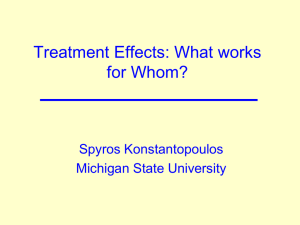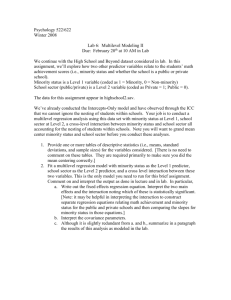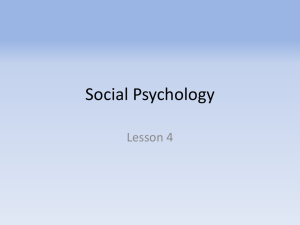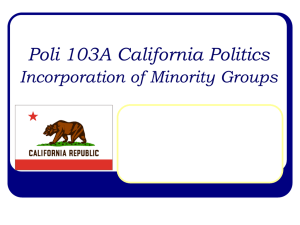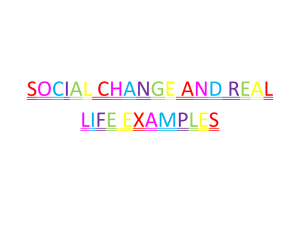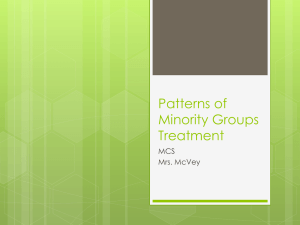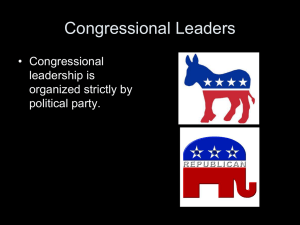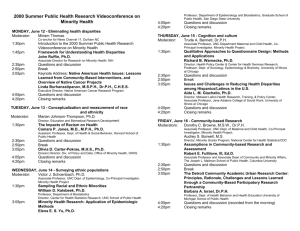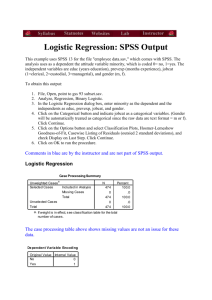power point
advertisement
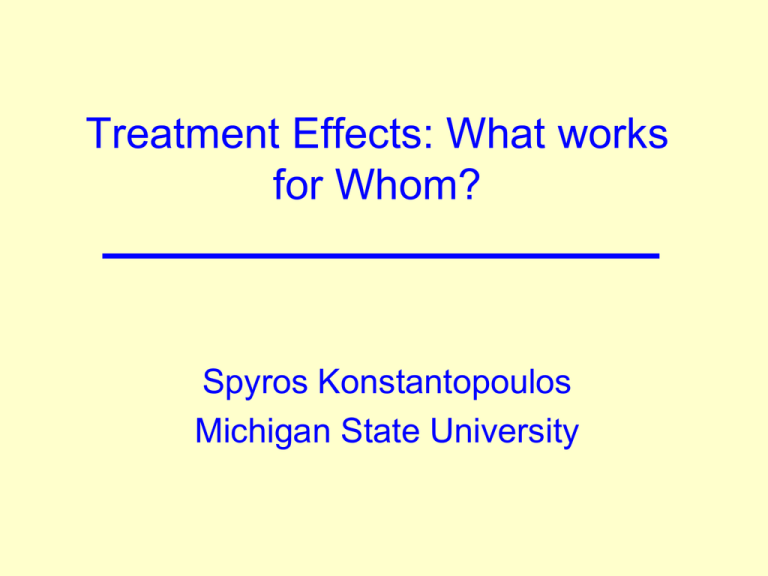
Treatment Effects: What works for Whom? Spyros Konstantopoulos Michigan State University Main Treatment Effects • Typically We Calculate an Average Treatment Effect • Typically We Are Interested in Estimating Treatment Effects for ALL Individuals in the Sample • We Compute an Average Difference Between Treatment and Control Groups in Outcomes of Interest (e.g., Achievement) for ALL Individuals (Main Effect) Main Treatment Effects • In the Simplest Case We Can Conduct a t-test for Independent Samples to Examine the Significance of the Main Treatment Effect • Alternatively (and Equivalently) We Can Run a Simple Regression (with a Dummy Variable for Treatment). The t-test is the Same (Assuming the Variances in the Two Groups Are Equal) Does the Treatment Have the Same Effect On ALL Groups of Individuals? • School Interventions Have Frequently Dual Objectives: – Increase Achievement for All Students – Decrease the Achievement Gap • Note that Decreasing the Achievement Gap Suggests that the Treatment Effect is NOT the Same for ALL Students • Some Students May Benefit More from Treatments than Others Does the Treatment Have the Same Effect On ALL Groups of Individuals? • School Interventions May Have Different Effects on Minority and Disadvantaged Students (Hopefully Positive) • This Could Be a Byproduct of the Intervention or Could be the Intention by Design • The Objective Is to Reduce/Close the Achievement Gap (Gender, Race, or SES Gap) Differential Effects • Exposure to Treatment Differs for Different Groups of People • The Effectiveness of the Treatment Varies Across Groups • These Are Called Differential Effects of the Treatment on Groups of Individuals Differential Effects • For Example Small Classes May Be More Beneficial to Low Achievers or Minority Students • Low Achievers May Benefit More from Effective Teachers • These Differential Effects Are Introduced in Regression Models as Statistical Interactions Interaction Effects • Interaction Effects Are a Related Notion to Differential Effects • The Idea Is that the Treatment Interacts with Individual Characteristics (e.g., Minority Status) • Through the Interaction the Treatment Could Be Maximized for a Specific Group of Individuals and a Specific Outcome (e.g., Achievement) Interaction Effects • Pioneering Work by Cronbach and Snow (1977) Discussed Aptitude-Treatment Interactions in Education • The Idea is that a Treatment (e.g., Highly Structured Instruction) May Benefit Some Students (e.g., Low Achievers) More than Others Moderator Effects • Variables that Interact with Treatments Are Called Moderators and Indicate the Degree to Which the Treatment Effect on an Outcome Depends on the Moderator (Baron & Kenny, 1986) • Moderator Variables Can be Categorical (e.g., Gender), Ordinal (e.g., SES), or Continuous (e.g., Ability) • Analytically, Interaction or Moderator Effects Are Introduced in Linear Regression Models as Statistical Interactions What is a Statistical Interaction? • Suppose We Are Interested in Examining Whether Small Classes Increase Minority Students’ Achievement More than Other Students • We Can Construct Two Binary Variables for Small Class and for Minority Status and Create an Interaction by Multiplying the Two Variables • In this Example Minority Status Is a Moderator Variable. The Idea is that the Effect of Small Class is Different for Minorities than for Whites Modeling Statistical Interaction • We Discuss Here Two-Way Interactions Between Two Variables • To Model Interactions We Include in the Regression All Main Effects (e.g., Small Class and Minority) and the Two-Way Interaction (the Product of the Two Variables) Modeling Statistical Interaction • Suppose Treatment (T) is Dummy Variable (e.g., Small Class = 1, Else 0) and Moderator (M) is Dummy Variable (e.g., Minority Student = 1, Else 0) • The Simplest Way to Model the Interaction Effect Is yi b0 bT 1 i b2 M i b3Ti * M i ei • Where y Is Outcome, e Is Residual, and b’s Need to Be Estimated (b3 Is the Coefficient of Interest) Hypothesis Testing • The Null Hypothesis States that the Interaction Term is Zero • The Alternative Hypothesis States that the Interaction Term is Different than Zero • In this Case the Most Important Coefficient Is the Interaction Effect • When the t-test Is Significant the Treatment Effect Is Moderated Data • Project STAR is a Longitudinal Field Experiment • Students and Teachers Were Randomly Assigned to Small and Regular Size Classes Within Schools • What Kind of Design Is this? Analysis Regression Model: Yij β00 +β11Small +β12 Minority + β13Interaction + ε ij Results Interpreting Statistical Interactions • Intercept/Constant: Average Math Achievement of White Students in Regular Classes • Minority Coefficient: Average Minority-White Math Achievement Gap in Regular Classes • Small Class Coefficient: Average Math Difference Between Small and Regular Classes for Whites • Interaction Coefficient: Minority Students In Small Classes Scored on Average .088 Points Higher on the Math Scale than their White Peers in Small Classes (Essentially the Difference in Math of the Class Size Benefit for Minority and White Students) • OR Minority Students in Small Classes Scored on Average .088 Points Higher on the Mathematics Scale than Minority Students in Regular Classes (Essentially the Difference in Math of the MinorityWhite Gap for Small and Regular Classes) Centering Main Variables • Some Researchers Center the Treatment and Moderator Variables at their Means and then Compute the Product Term • Centering Helps with Collinearity and Affects Only Estimates of Main Effects and their Standard Errors (NOT Interactions) • Standard Errors Should be Smaller • Of Course the Intercept Is Different as Well Results: Centered Variables
